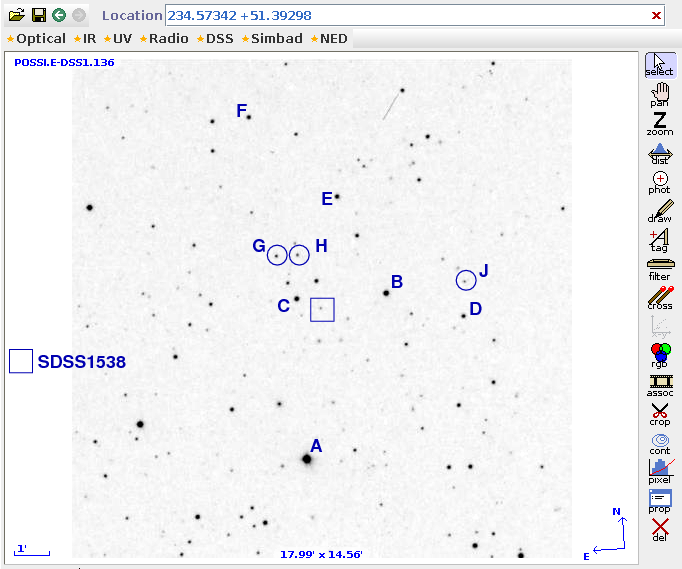
On the night of May 04/05, 2013, I attempted to observe for the first time the cataclysmic variable known as SDSSJ1538+5123. The Hubble Space Telescope will observe this object later this month (May 16-17), so it's important to monitor its brightness.
The setup was:
Notes from the night
This is a chart of the field of SDSSJ1538, taken from Aladin and the POSS I E plate. The target is in the square box near the middle of the field.

You can find information on the star, including a photometric sequence of comparison stars nearby, at the AAVSO's entry for SDSS1538 in the International Variable Star index.
AUID letter RA. Dec. B V B-V ------------------------------------------------------------------------------------------ 000-BJR-224 A 15:38:51.06 51:20:37.2 13.186 (0.077) 12.617 (0.061) 0.569 (0.098) 000-BJR-225 B 15:38:05.33 51:23:57.9 13.998 (0.006) 13.343 (0.006) 0.655 (0.008) 000-BJR-226 C 15:38:21.62 51:23:55.9 14.756 (0.008) 14.170 (0.008) 0.586 (0.011) 000-BJR-227 E 15:38:13.33 51:26:46.1 15.843 (0.010) 15.082 (0.010) 0.761 (0.014) 000-BJR-228 F 15:38:28.57 51:29:09.1 15.820 (0.004) 15.295 (0.000) 0.525 (0.004) 000-BJR-229 D 15:37:51.56 51:23:10.8 16.732 (0.017) 15.691 (0.017) 1.041 (0.024) 000-BJR-230 15:38:37.21 51:23:54.9 16.670 (0.010) 16.161 (0.008) 0.509 (0.013) 000-BJR-231 15:37:58.24 51:27:07.2 17.283 (0.011) 16.443 (0.008) 0.840 (0.014) 000-BJR-232 15:38:39.75 51:25:36.2 17.897 (0.022) 17.117 (0.011) 0.780 (0.025) 000-BJR-233 G 15:38:24.80 51:25:11 18.194 (0.036) 17.360 (0.008) 0.834 (0.037) 000-BJR-234 H 15:38:21.08 51:25:10.8 18.777 (0.047) 17.864 (0.000) 0.913 (0.047) 000-BJR-235 J 15:37:50.99 51:24:10.5 18.951 (0.025) 18.265 (0.008) 0.686 (0.026) ------------------------------------------------------------------------------------------ Report this sequence as: 11711AGH in the chart field of your observation report.The brightest star, marked "Q", is UCAC4-707-053459, and has magnitude V = 10.77. The target, SDSS1538, is much fainter, with a magnitude in quiescence of roughly V = 18.
I first took a series of 60-second R-band exposures, but quickly realized that the target was completely invisible. I found a good guide star in the area: if one places star "Q" in the main CCD at position (164, 287), the guide CCD will show a bright star. I was unable to calibrate the guider, because the Dec axis sticks frequently. Nonetheless, the guider did a pretty good job of keeping the telescope fixed in place. The guide star would typically drift very slowly in Dec until, after several minutes, the mount would finally jump in Dec by several arcsec, but that was good enough for my purposes.
I increased the exposure time to 120 seconds and switched to a "clear" filter. These images finally showed the target as a very faint source. I was able to produce a decent signal by stacking a number of these two-minute exposures. The stacked image had decent (for Rochester) quality: FWHM = 2.3 pixels = 4.2 arcsec.
Using aperture photometry with a radius of 4 pixels (radius of 7.4 arcsec), I measured the instrumental magnitudes of a number of reference stars and the target. Remember, the measurements are all taken with no filter. There are two ways to estimate the magnitude of SDSS 1538.
V = (instr. clear mag) + 1.06 +/- 0.08 mag
from which we can derive
SDSS 1538 "V"(nocolor) = 18.7
V = (instr. clear mag) + 0.761 + 0.3787 * (B-V)
from which we can derive
SDSS 1538 "V"(incl.color) = 18.4
Let me summarize my results:
# Measurements of SDSS 1538+5123 # made by Michael Richmond at the RIT Observatory # with 12-inch Meade LX200 + SBIG ST-8E CCD. # No filter, stacked (8 x 120-second) exposure # Conditions were good: clear, dark skies. # # Aperture photometry with radius 4 pix = 7.4 arcsec. # Reference star photometry from AAVSO chart 11713LT # "V" mag is based on unfiltered measurements, # compared to V-band reference magnitudes, no color terms. # # UT Date UT JD "V" mag #---------------------------------------------- 2013 May 05 02:26 2456417.601 18.7 +/- 0.3
Last modified 05/06/2013 by MWR.